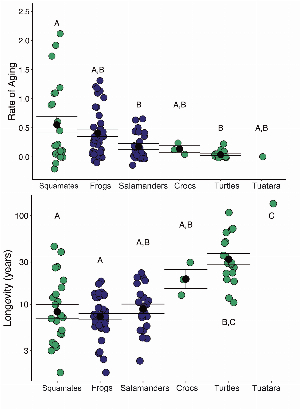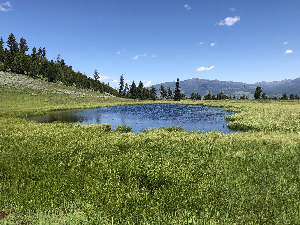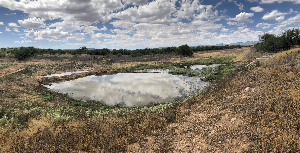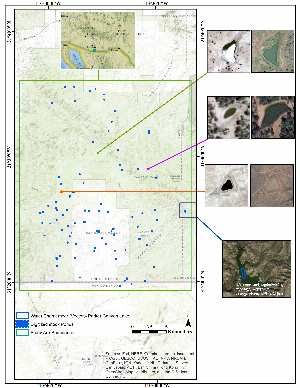Search ARMI Database
Search term(s)
Contribution Number
Search Results
146 record(s) found.
Papers & Reports Diverse aging rates in ectotherms provide insights for the evolution of aging and longevity
Papers & Reports Comparative Effects of Energy-Related Saline Wastewaters and NaCl on Hatching, Survival, and Fitness-Associated Traits of Two Amphibian Species
contaminant that negatively affects freshwater ecosystems. Although
most studies focus on effects of salinity from roads salts (primarily
NaCl), high-salinity wastewaters from energy extraction (wastewaters)
could be more harmful because they contain NaCl and other toxic
components. Many amphibians are sensitive to salinity and their eggs
are thought to be the most sensitive life history stage. However, there
are few investigations with salinity that include eggs and larvae
sequentially in long-term exposures. We investigated the relative effects
of wastewaters from a large energy reserve, the Williston Basin (USA),
and NaCl on northern leopard (Rana pipiens) and boreal chorus
(Pseudacris maculata) frogs. We exposed eggs to salinity and tracked
responses through larval stages (for 24 days). Wastewaters and NaCl
reduced hatching and larval survival, growth, development, and activity
while also increasing deformities. Chorus frog eggs and larvae were
more sensitive to salinity than leopard frogs suggesting species-specific
responses. Contrary to previous studies, eggs of both species were less
sensitive to salinity than larvae. Our ecologically relevant exposures
suggest that accumulating effects can reduce survival relative to starting
experiments with unexposed larvae. Alternatively, egg casings of some
species may provide some protection against salinity. Notably, effects of
wastewaters on amphibians were predominantly due to NaCl rather than
other components. Therefore, findings from studies with other sources of
increased salinity (e.g., road salts) could guide management of
wastewater-contaminated ecosystems, and vice versa, to mitigate
effects of salinization.
Papers & Reports Amphibian population responses to mitigation: relative importance of wetland age and design
Papers & Reports Corticosterone Mediates a Growth-Survival Tradeoff for an Amphibian Exposed to Increased Salinity
Papers & Reports Evaluating Corticosterone as a Biomarker for Amphibians Exposed to Increased Salinity and Ambient Corticosterone
Papers & Reports Metal accumulation varies with life history, size, and development of larval amphibians
Papers & Reports Staggered-entry analysis of breeding and occupancy dynamics of Arizona Toads from historically occupied habitats of New Mexico, USA
Papers & Reports Thermal conditions predict intraspecific variation in senescence rate in frogs and toads
News & Stories ARMI Scientists Assist NPS Monitoring Program with Symposium and Program Review
During December 8–10, 2020, the NPS-Greater Yellowstone Network hosted a virtual three-day amphibian and wetland science symposium entitled Linking Monitoring and Research to Amphibian Conservation in the Greater Yellowstone Ecosystem. This symposium highlighted work related to the NPS program that has monitored amphibian and wetland dynamics in Grand Teton and Yellowstone national parks since 2006. USGS-ARMI has been linked with monitoring program since the inception of the NPS monitoring program and assisted with organizing symposium presentations.
The three-day symposium served two important purposes. The first two days were intended to bring together practitioners of amphibian monitoring and park natural resource personnel with university, non-governmental scientists, and USGS scientists. Participants shared examples from their work and the current state of knowledge about research and monitoring of amphibians and their habitats. Reflecting the long history of ARMI research in the Rocky Mountains and on NPS lands, there were five presentations by ARMI scientists, and seven presentations highlighted on-going or recently completed ARMI research.
The third day was structured to provide a formal peer review of the network’s amphibian and wetland monitoring protocol. The eight reviewers, which included ARMI scientist Brian Halstead and former ARMI PhD student Paige Howell, offered recommendations to enrich and strengthen the Greater Yellowstone Network ’s ongoing monitoring efforts. In total, more than 60 people participated in the symposium and program review.
ARMI and the Greater Yellowstone Network will continue their collaboration by co-organizing a special issue in the journal Ecological Indicators. The issue will include several papers that highlight collaborative USGS-NPS research on amphibians, wetlands, and climate, as well as emerging tools and priorities for scientists and resource managers.
Papers & Reports Enigmatic Near-Extinction in a Boreal Toad Metapopulation in Northwestern Montana
Papers & Reports Accommodating the role of site memory in dynamic species distribution models using detection/non-detection data
Data Release Data realease for manuscript: A statistical forecasting approach to metapopulation viability analysis
News & Stories Information from ARMI surveys guides management action in the Desert Southwest
The Buenos Aires National Wildlife Refuge (BANWR) has developed a new pond designed to replicate ciénega conditions that will provide habitat for the federally threatened Chiricahua leopard frog. Reintroduced to the Refuge after extirpation in the early 2000s, the Chiricahua leopard frog has colonized areas beyond the initial reintroduction sites, now inhabiting several human-made stock tanks on the Refuge. The species’ persistence on the Refuge depends on the ongoing eradication of invasive bullfrogs and the availability of water. In desert habitats such as BANWR, the ciénega (a Spanish word for wetland) is a marsh-like habitat that is critical for numerous desert-dwelling creatures. Ciénegas on BANWR are characterized by a spring or seep that saturates the soil and allows water to pool in small areas (Hendrickson and Minckley, 1985). Ciénega vegetation includes rushes, watercress, and smartweed; they are often bordered by cottonwood and willow trees which the Refuge will plant at the new ciénega once the water has settled into the excavated depression. The new ciénega on BANWR is plumbed, meaning that water levels can be modified and maintained in response to environmental conditions that range from multi-year droughts to heavy monsoon conditions (Bezy et. al. 2007).
ARMI has collected data at BANWR since 2000, gathering information about native species (e.g., Chandler et al. 2015, Jarchow et al. 2016, , Howell et al. 2018, 2020a), invasive species such as American bullfrogs and sunfish (Suhr 2010, Howell et al. 2020b), and disease (Sigafus et al. 2014). Models assessing occupancy and movement of the Chiricahua leopard frog indicate that water availability and permanency are critical components to the its persistence at BANWR. The Refuge has used this information to make decisions about management actions such as building plumbed ponds — a non-trivial action in terms of cost and logistics. The new ciénega will not only support the Chiricahua leopard frog but will provide water for many other species that call BANWR home including the federally endangered masked bobwhite quail, great blue herons, yellow-billed cuckoos, and pronghorn.
Bezy, J., C. F. Hutchinson, and C. J. Bahre. 2007. Buenos Aires National Wildlife Refuge, 373 Arizona. Desert Plants 23:3–44.
Chandler, R., E. Muths, B. H. Sigafus, C.R. Schwalbe, C. Jarchow, and B.R. Hossack. 2015. Realizing the potential of spatially explicit metapopulation theory for predicting extinction risk. Journal of Applied Ecology. DOI: 10.1111/1365-2664.12481.
Howell, P., E. Muths, B.R. Hossack, B.H. Sigafus, and R.B. Chandler. 2018. Increasing connectivity between metapopulation ecology and landscape ecology. Ecology 99: 1119-1128.
Howell, P.E., B.R. Hossack, E. Muths, B. Sigafus, A. Chenevert- Steffler, and R. Chandler. 2020a. A statistical forecasting approach to metapopulation viability analysis. Ecological Applications 30(2), e02038
Howell, P.E. E. Muths, B.H. Sigafus, and B.R. Hossack. 2020b. Survival estimates for the invasive American bullfrog. Amphibia-Reptilia.
Hendrickson, D. A. and W. L. Minckley. 1985. Ciénegas vanishing climax communities of the American southwest. Desert Plants 6 (3): 131-175.
Sigafus, B. H., C.R. Schwalbe, B.R. Hossack, and E. Muths. 2014. Prevalence of the amphibian chytrid fungus at Buenos Aires National Wildlife Refuge, Arizona. Herpetological Review 45: 41-42.
Suhre, D. O. 2010. Dispersal and demography of the American Bullfrog (Rana catesbeiana) in a 455 semi-arid grassland. M.S. Thesis, University of Arizona, USA.




